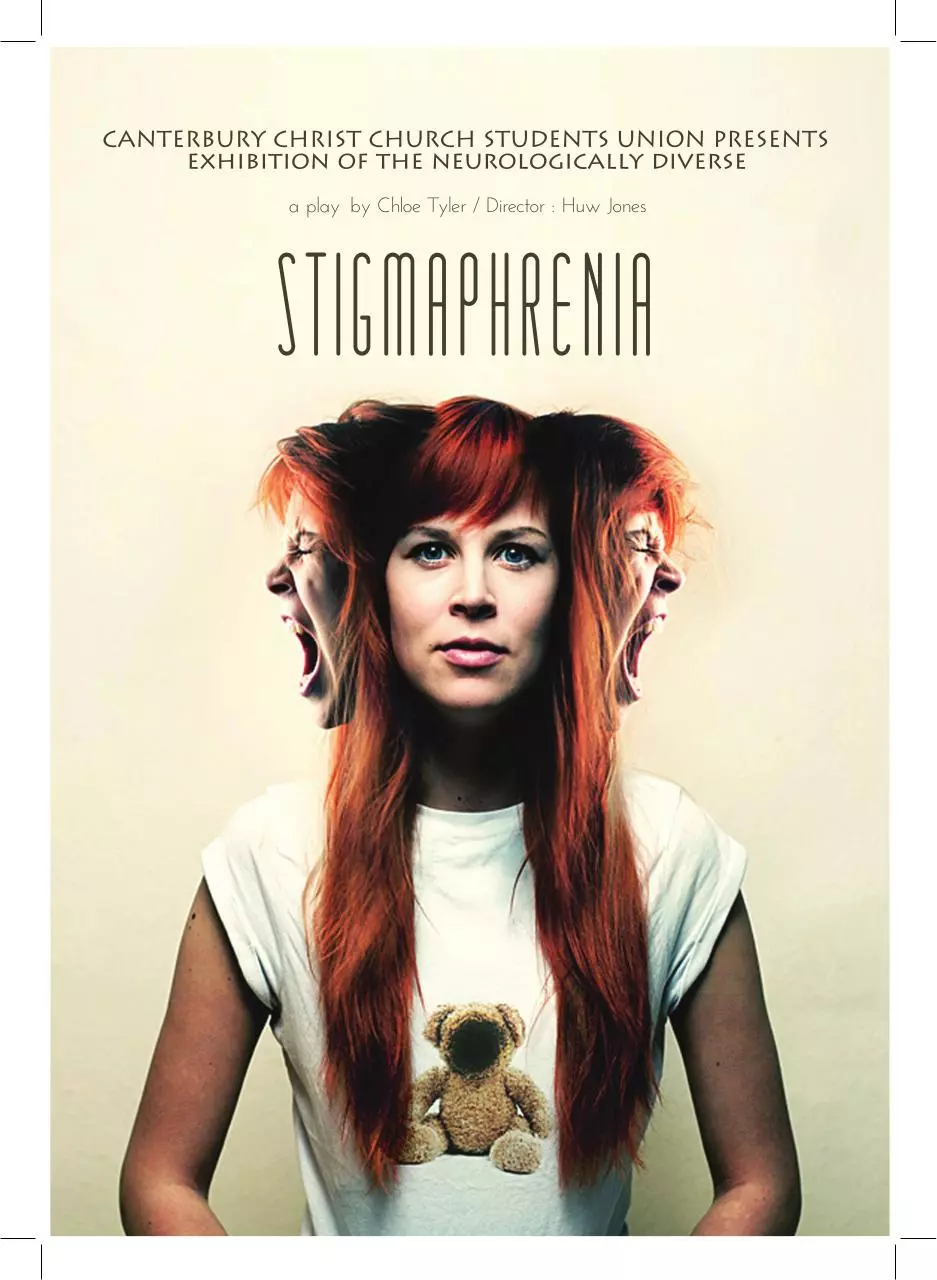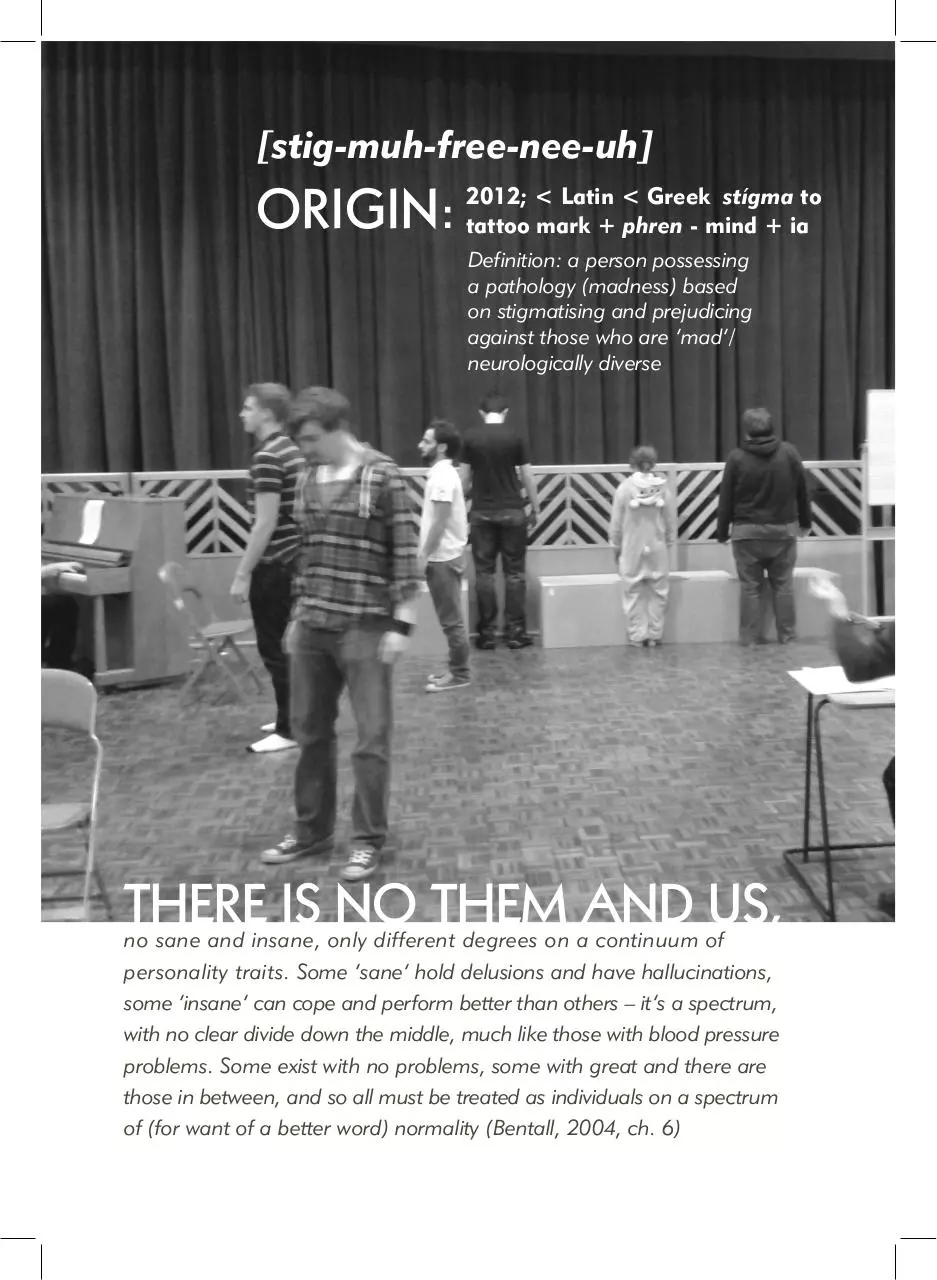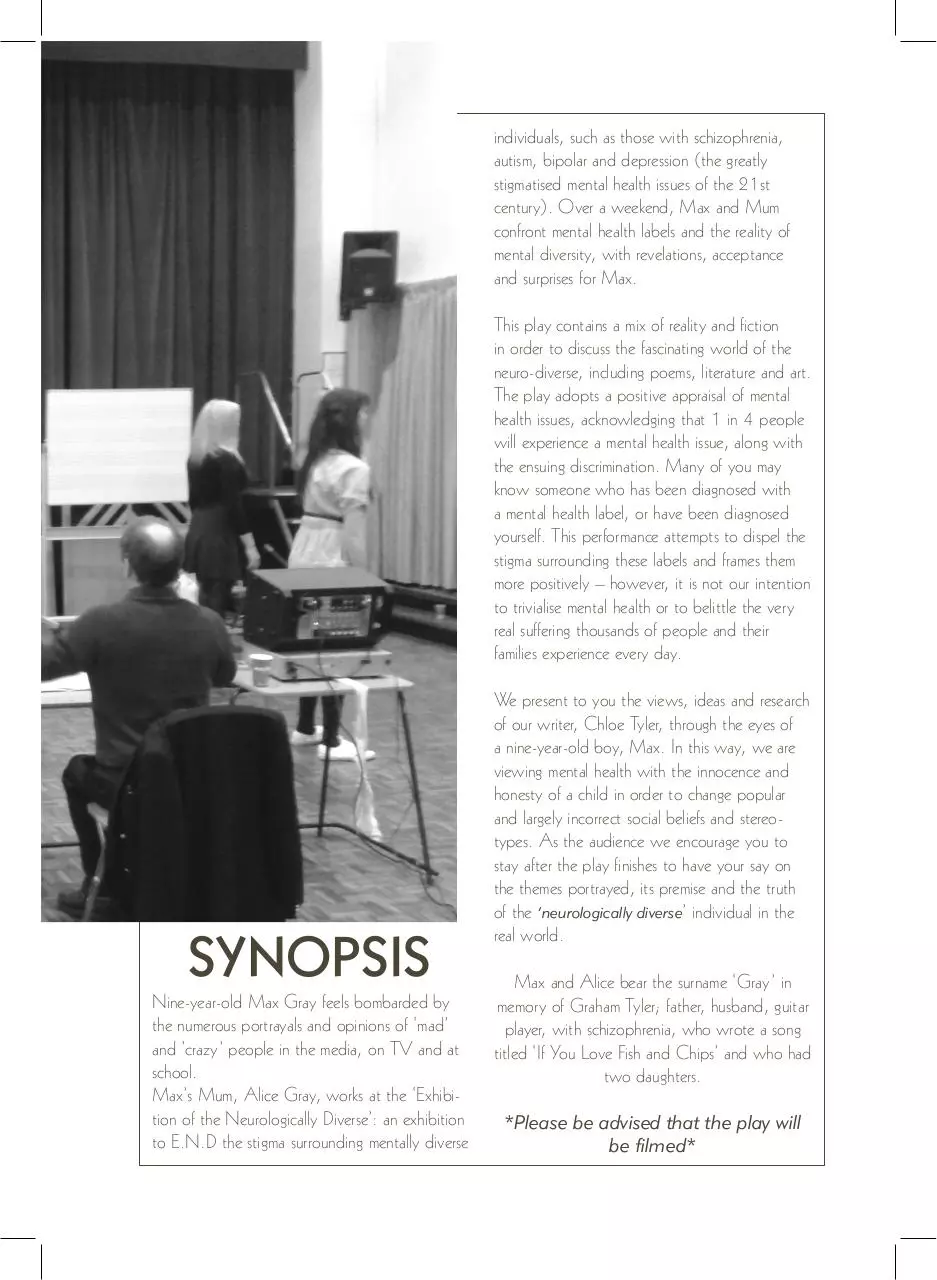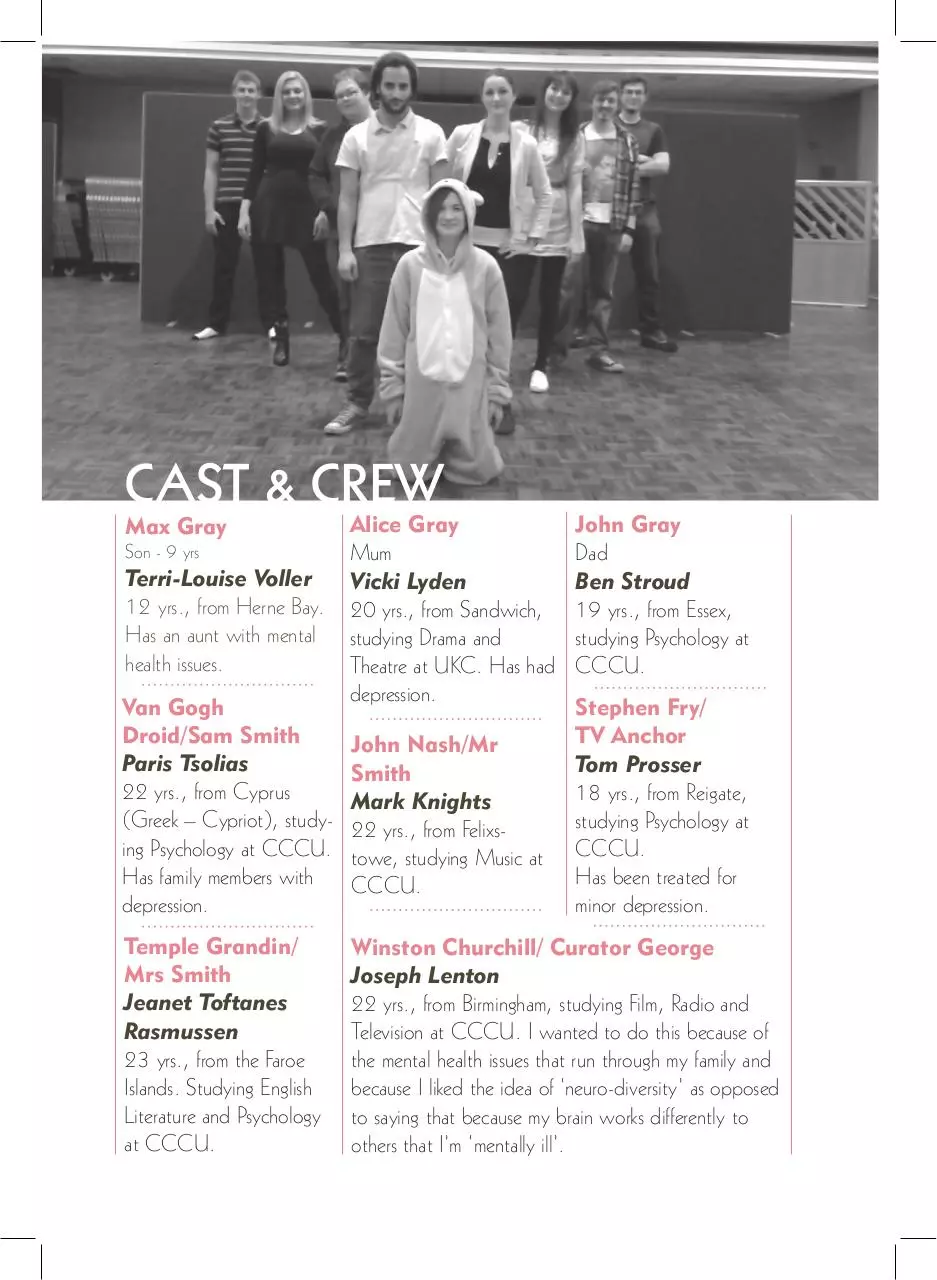Stigmaphrenia (PDF)
File information
This PDF 1.4 document has been generated by Adobe InDesign CS5 (7.0) / Adobe PDF Library 9.9, and has been sent on pdf-archive.com on 15/04/2013 at 16:03, from IP address 92.20.x.x.
The current document download page has been viewed 2871 times.
File size: 6.49 MB (12 pages).
Privacy: public file





File preview
[stig-muh-free-nee-uh]
2012; < Latin < Greek stígma to
ORIGIN: tattoo
mark + phren - mind + ia
Definition: a person possessing
a pathology (madness) based
on stigmatising and prejudicing
against those who are ‘mad’/
neurologically diverse
THERE IS NO THEM AND US,
no sane and insane, only different degrees on a continuum of
personality traits. Some ‘sane’ hold delusions and have hallucinations,
some ‘insane’ can cope and perform better than others – it’s a spectrum,
with no clear divide down the middle, much like those with blood pressure
problems. Some exist with no problems, some with great and there are
those in between, and so all must be treated as individuals on a spectrum
of (for want of a better word) normality (Bentall, 2004, ch. 6)
individuals, such as those with schizophrenia,
autism, bipolar and depression (the greatly
stigmatised mental health issues of the 21st
century). Over a weekend, Max and Mum
confront mental health labels and the reality of
mental diversity, with revelations, acceptance
and surprises for Max.
This play contains a mix of reality and fiction
in order to discuss the fascinating world of the
neuro-diverse, including poems, literature and art.
The play adopts a positive appraisal of mental
health issues, acknowledging that 1 in 4 people
will experience a mental health issue, along with
the ensuing discrimination. Many of you may
know someone who has been diagnosed with
a mental health label, or have been diagnosed
yourself. This performance attempts to dispel the
stigma surrounding these labels and frames them
more positively – however, it is not our intention
to trivialise mental health or to belittle the very
real suffering thousands of people and their
families experience every day.
SYNOPSIS
Nine-year-old Max Gray feels bombarded by
the numerous portrayals and opinions of ‘mad’
and ’crazy’ people in the media, on TV and at
school.
Max’s Mum, Alice Gray, works at the ‘Exhibition of the Neurologically Diverse’: an exhibition
to E.N.D the stigma surrounding mentally diverse
We present to you the views, ideas and research
of our writer, Chloe Tyler, through the eyes of
a nine-year-old boy, Max. In this way, we are
viewing mental health with the innocence and
honesty of a child in order to change popular
and largely incorrect social beliefs and stereotypes. As the audience we encourage you to
stay after the play finishes to have your say on
the themes portrayed, its premise and the truth
of the ‘neurologically diverse’ individual in the
real world.
Max and Alice bear the surname ‘Gray’ in
memory of Graham Tyler; father, husband, guitar
player, with schizophrenia, who wrote a song
titled ‘If You Love Fish and Chips’ and who had
two daughters.
*Please be advised that the play will
be filmed*
CAST & CREW
Max Gray
Son - 9 yrs
Terri-Louise Voller
12 yrs., from Herne Bay.
Has an aunt with mental
health issues.
Van Gogh
Droid/Sam Smith
Paris Tsolias
22 yrs., from Cyprus
(Greek – Cypriot), studying Psychology at CCCU.
Has family members with
depression.
Temple Grandin/
Mrs Smith
Jeanet Toftanes
Rasmussen
23 yrs., from the Faroe
Islands. Studying English
Literature and Psychology
at CCCU.
Alice Gray
Mum
Vicki Lyden
20 yrs., from Sandwich,
studying Drama and
Theatre at UKC. Has had
depression.
John Nash/Mr
Smith
Mark Knights
22 yrs., from Felixstowe, studying Music at
CCCU.
John Gray
Dad
Ben Stroud
19 yrs., from Essex,
studying Psychology at
CCCU.
Stephen Fry/
TV Anchor
Tom Prosser
18 yrs., from Reigate,
studying Psychology at
CCCU.
Has been treated for
minor depression.
Winston Churchill/ Curator George
Joseph Lenton
22 yrs., from Birmingham, studying Film, Radio and
Television at CCCU. I wanted to do this because of
the mental health issues that run through my family and
because I liked the idea of ‘neuro-diversity’ as opposed
to saying that because my brain works differently to
others that I’m ‘mentally ill’.
Play Creator
Chloe Tyler
28 yrs., from Canterbury,
studying Psychology at
CCCU. My mother has
bipolar and my father had
schizophrenia. I have had
depression.
Camera
Holly-Mae Worf
22 yrs., from Kent
Consultant Director Music
Marek Beck
Huw Jones
19 yrs., from Slovakia,
From Faversham.
studying Psychology at
mansel@waitrose.com
CCCU.
Sound/music/lights
Japanese shadow
technician
puppets
Alex Branson
Sarah Childs
20 yrs., from Norwich,
studying Media and Cultural Artist and writer, specialising in Manga www.
studies at CCCU.
gyzra.com sarahchilds@
Japanese shadow
puppet screen/carPaintings
pentry
Lynn Tyler
Paul Cullen
From Medway
P J Cullen, carpenProgramme design try joinery and genJemma Elliott
eral construction, Deal,
Faversham based illustrator/ 07809125455
graphic designer. Find her at
missjemmaelf.wordpress.com Promotional photography
Poster model
Michal Marko
Katka Kate Madzin from Slovakia, Studying at
23 yrs., from Slovakia,
CCCU.
studying Performing Arts
http://www.michalmarko.com
at CCCU.
gyzra.com,
Essex,
07595423395
Puppeteers
Connor Stiff
19 yrs., studying History
and Archaeology.
Sarah Partington
21 yrs., studying English
Language, both at
CCCU.
Famous Persons With Not-So-Famously
Obvious Neuro-Diversities
(definitely not exhaustive, for more examples see:
http://www.ndsu.edu/fileadmin/counseling/famous.pdf)
Vincent van Gogh - Biploar (?)
Stephen Wiltshire - Autism
Temple Grandin - Autism
Winston Churchill - Depression
John Nash - Schizophrenia
Stephen Fry - Bipolar
neuro-diversity. So, let’s try not calling
mental illness, illness, and think of it as
a diverse trait: a part, both significant
and insignificant, of one’s personality.
CREATOR:
“Existentialists believed that
madness and sanity are social
constructs with the mad
being perceptive individuals
who tried to adjust to societal
norms while seeing through
pretence.”
Chloe (Tresoi) Tyler.
Nathaniel Lee, Bedlam,
2008, pg. 268
“There are aspects of depression I miss;
I wrote some, subjectively, half decent
poems when depressed. On the flip
side I don’t miss the isolation, but, like
any personality trait, there are good
and bad aspects to mental deviance/
It’s Time to Change how we think and
behave towards those who are different
to ourselves; there’s nothing wrong with
noticing differences, it’s only when we
act negatively because someone is different
that we lose our humanity.”
INFORMATION & HELP
Autism;
The National Autistic Society;
http://www.autism.org.uk
Schizophrenia;
Time to Change;
http://www.time-to-change.org.uk
and Mind;
http://www.mind.org.uk/timetochange
Bipolar;
Bipolar UK;
http://www.bipolaruk.org.uk
Depression;
Depression Alliance;
http://www.depressionalliance.org
POEMS AND QUOTES
Robert Burton – Anatomy of Melancholy,
1651-2, pg. 26
But see the madman rage downright
With furious looks, a ghastly sight.
Naked in chains bound doth he lie,
And roars amain he knows not why!
Observe him; for as in a glass,
Thine angry portraiture it was.
His picture keeps still in thy presence;
‘Twixt him and thee, there’s no difference.
“Do you think I’ve gone round the bend?”
“I’m afraid so. You’re mad, bonkers, off your head.
But I’ll tell you a secret: all the best people are.”
Alice (in Wonderland film) and her father, 2010
Anon - A Scream for Help
If a problem shared be a problem halved,
Then to tell enough will be a problem solved.
If oh so simple and of endless friends,
Why are they still, the problems don’t end.
I could tell forever of my troubled mind,
But no good would come, the world is blind.
I forever carry the tortured grief,
Of a life stolen, stolen by a thief.
I feel I’m cheated, devoid of childhood,
Removed from memory, no trace of any good.
All that’s left is this tiny girl,
With no significance nor influence to the world.
I’m dead as I live and happy as sad.
For I know I can’t change, my life has gone bad.
“Madness need not be regarded as
an illness. Why shouldn’t it be seen
as a sudden – more or less sudden –
change of character?”
“You’re only given
a little spark of
madness. You
mustn’t lose it.”
Ludwig Wittgenstein
Robin Wiliams
Rudyard Kipling - We and They
“Father, Mother, and Me,
Sister and Auntie say
All the people like us are We,
And everyone else is They,
And They live over the sea,
While We live over the way,
But – would you believe it? – They look upon We
As only a sort of They.”
“They said I was mad: and
I said they were mad: damn
them, they outvoted me!”
Nathaniel Lee, Bedlam,
2008, pg. 112
“Insanity: doing the same thing
over and over again and expecting
different results.”
Albert Einstein (1879 - 1955)
“Equality is sanity.”
George Orwell
Evolutionary ‘pundit’ scene
from Stigmaphrenia:
The fact that neuro diversities such as schizophrenia and autism are
so universally and historically prevalent throughout human history
strongly indicates that they are a genetic variation within the species,
which either has had a past advantage for the species, or has the
capability of being adaptive in the uncertain future.
We can never know what traits in our species
will be beneficial to our survival. Survival of the
fittest does not mean the strongest and biggest;
it means those who are best suited to fit into
their current environment. If an organism is alive,
and thus surviving, then they are the fittest to
live in their environment – even without trying
to control and eradicate diversities such as
schizophrenia they would still occur throughout the known population of the world. In
tribal communities these individuals are revered
as Shamans, in our society they are feared,
degraded and stigmatised: of the two civilisations
which is close minded?
Scientists, psychologists and governments have
repeatedly throughout history tried to remove
these individuals and their genes from the human
race, they have not succeeded, and they have
not even reduced their occurrence - surely, this
must tell us something: these diversities are here
to stay. Therefore, it is time to try something
new –as Einstein said “Insanity [is] doing the
same thing over and over again and expecting
different results“. Looked at this way approaching neuro-diversity negatively, trying to rid the
world of these exceptional people, and then
failing to even dent their prevalence, is insanity.
The neuro-diverse are not mistakes in humanity to
be eradicated: in nature and evolution there are
no mistakes, only variations.
What would we miss if we no longer had these
traits in humanity?; Creativity, thinking outside
the box: humanity as we know it. Neuro-diversity could conceivably have been here since the
first human and we have neither fully discovered
it or quelled it. So, perhaps it is time to approach it in a different way, accept it is here to
stay, that it makes us human and that without it
we would not achieve such greatness. Depression is not just great sadness, but the ability to
empathise with others: bipolar is not just highs
and lows, but great warmth and love: schizophrenia is not just hearing voices, but creativity
and a way of thinking differently. Nothing is ever
black and white: humanity is more than one type
of person and personality, it is no coincidence
that those who have achieved greatness had a
diverse mind, they were so much more than sadness, highs and lows and hearing voices.
Darwin’s main tenet considered ‘that to be
robust and successful, a species needs to be
as diverse as possible, allowing for millions of
possible reactions to evolutionary pressures. If
allowed to, us humans could conceivably genetically engineer ourselves into oblivion (Antonetta,
2007, p.212).’
Leave comments and feedback after the
performances on our facebook page
www.facebook.com/Stigmaphrenia
Adriaens, P. R. (2008). Debunking evolutionary psychiatry’s schizophrenia paradox.
Medical hypotheses, 70(6), 1215–22. doi:10.1016/j.mehy.2007.10.014
Antonetta, S. (2007). A Mind Apart: Travels in a Neuordiverse World. London: Penguin
Books Ltd.
Bentall, R. P. (2004). MADNESS EXPLAINED, PSYCHOSIS AND HUMAN NATURE.
London: Penguin Books Ltd.
Boyle, M. (2007). The problem with diagnosis. PSYCHOLOGIST-LEICESTER-,
20(5), 290–295. Retrieved from http://www.thepsychologist.org.uk/archive/archive_home.cfm/volumeID_20-editionID_147-ArticleID_1184-getfile_getPDF/
thepsychologist%5C0507dia1.pdf
Burns, J. (2007). The Descent of Madness, Evolutionary Origins of Psychosis and the
Social Brain. East Sussex: Routledge.
Burton, R., & Bullen, A. (1896). The anatomy of melancholy. Retrieved from http://
scholar.google.com/scholar?hl=en&btnG=Search&q=intitle:The+anatomy+of+mela
ncholy#0
Crow, T. J. (2008). The “big bang” theory of the origin of psychosis and the faculty of
language. Schizophrenia research, 102(1-3), 31–52. doi:10.1016/j.schres.2008.03.010
Erlenmeyer-Kimling, L., & Paradowski, W. (1966). Selection and schizophrenia.
American Naturalist, 100(916), 651–665. Retrieved from http://www.jstor.org/stable/10.2307/2459302
Pearlson, G. D., & Folley, B. S. (2008). Schizophrenia, psychiatric genetics, and Darwinian psychiatry: an evolutionary framework. Schizophrenia bulletin, 34(4), 722–33.
doi:10.1093/schbul/sbm130
Sacks, O. (2012). Hallucinations. England: Picador.
www.facebook.com/Stigmaphrenia
Download Stigmaphrenia
Stigmaphrenia.pdf (PDF, 6.49 MB)
Download PDF
Share this file on social networks
Link to this page
Permanent link
Use the permanent link to the download page to share your document on Facebook, Twitter, LinkedIn, or directly with a contact by e-Mail, Messenger, Whatsapp, Line..
Short link
Use the short link to share your document on Twitter or by text message (SMS)
HTML Code
Copy the following HTML code to share your document on a Website or Blog
QR Code to this page

This file has been shared publicly by a user of PDF Archive.
Document ID: 0000100805.